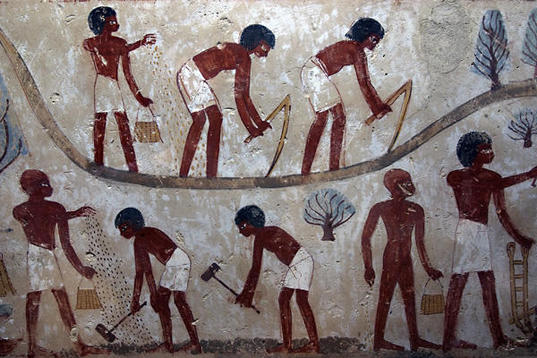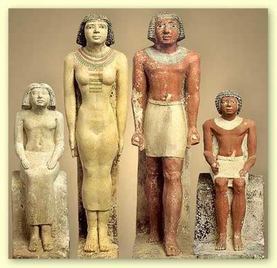Ancient Egypt
Economic Activities
With the access of the Nile River, it provide numerous benefits to the people of the famous civilization. The river encourage the growth and development of many economic activities such as agriculture, fishing, trading, mining, craftsmanship etc. These activities depend on the Nile River for the continuation and development of Ancient Egypt.
Social Society-Way of Life in Ancient Egypt
What are the roles of both male and female in Ancient Egypt?
Most of the Egyptians were peasant farmers. Many were slaves. Men and women spent their days working the soil and repairing the dikes.
Men
Men in Ancient Egypt took on roles such as priests (who served the gods and goddesses), nobles (who fought the Pharaoh's wars), merchants (who organized trading), scribes (who recorded ceremonies, taxes, and gifts, farmers, fishermen, artisans/craftworker (who made fine jewelery, furniture, and fabrics for the palaces and tombs of pharaohs and nobles) and miners.
In the off-season, peasant men were expected to serve the pharaoh by labouring to build palaces, temples, and tombs.
Females
Women's work was not confined to the home.
Females in Ancient Egypt acquired roles such as priestesses, farmers and doctors.Other females manufactured perfumes and textile, managed farming estates
Besides working in the fields, women also spent much time raising children, collecting water, and preparing food-these tasks were similar to those of peasant women today.
Most of the Egyptians were peasant farmers. Many were slaves. Men and women spent their days working the soil and repairing the dikes.
Men
Men in Ancient Egypt took on roles such as priests (who served the gods and goddesses), nobles (who fought the Pharaoh's wars), merchants (who organized trading), scribes (who recorded ceremonies, taxes, and gifts, farmers, fishermen, artisans/craftworker (who made fine jewelery, furniture, and fabrics for the palaces and tombs of pharaohs and nobles) and miners.
In the off-season, peasant men were expected to serve the pharaoh by labouring to build palaces, temples, and tombs.
Females
Women's work was not confined to the home.
Females in Ancient Egypt acquired roles such as priestesses, farmers and doctors.Other females manufactured perfumes and textile, managed farming estates
Besides working in the fields, women also spent much time raising children, collecting water, and preparing food-these tasks were similar to those of peasant women today.
Describe the lifestyles of the people in Ancient Egypt.
Religious System
The Ancient Egypt was polytheistic. Polytheistic means the belief in more than one gods.
Identify six gods in Ancient Egypt's religious system
Identify the main role of the priest
What is meant by the term "Mummification"?
Identify six gods in Ancient Egypt's religious system
Identify the main role of the priest
What is meant by the term "Mummification"?
Writing Records, Medicine, Science, Painting, Sculpture, Literature-Achievements
Writings
Learned scribes played an integral role in Ancient Egypt. Temple scribes kept records of ceremonies, taxes and gifts. Other scribes served nobles or the pharaoh. Besides learning to read and write, scribes also acquired skills in mathematics, medicine and engineering.
Define the below terms:
Hieroglyphics
Ideograms
Demotic
Define the below terms:
Hieroglyphics
Ideograms
Demotic
Medicine
Egyptian physicians believed in various kinds of magic. Their knowledge of mummification had exposed them to the human body. They were skilled in observing symptoms, diagnosing illnesses, and finding cures. Doctors performed complex surgical operations which they describe on papyrus scrolls. They also prescribe medicines such as anise, castor beans and saffron.
Astronomy
Egyptian priest-astronomer studied the heavens, mapping constellations and charting the movements of planets. With this knowledge, they developed a calendar that has 12 months of 30 days each and 5 days added at the end of each year. It is the basis of our modern calendar.
Engineering
Nile floods forced Egyptians to redraw the boundaries each year. The engineer develop practical geometry to survey the land. Geometry was used to calculate the size (exact) and location of ids and each block of stone to be placed in a pyramid. Huge building projects such as pyramids and irrigation systems required considerable skills in design and engineering.
Painting and Sculpture
The arts of Ancient Egypt included statues, wall paintings in tombs and carvings on temples. Some everyday scenes of trade, farming, family life or religious ceremonies. Others boast of victories in battles.
Egyptian Literature
The oldest literature of Ancient Egypt includes hymns and prayers to the gods, proverbs and love poems. Other writings tell of royal victories in battles.
Useful Links:



Assignment for 8(3)
ReplyDelete1) Define the following terms:
a) Mummification
b) Hieroglyphics
c) Demotic
d) Ideogram
e) Papyrus
f) Pyramids
g) Polytheistic
2) Why did the people of Ancient Egypt mummify the dead?
3) How did Egyptians record events?
4) State two economic activities of Ancient Egypt
5) State two roles of:
a) Men
b) Women
6) State the reasons for the collapse of the:
a) Old Kingdom
b) Middle Kingdom
c) New Kingdom
Due Friday class...March 9, 2018
Mr. Black, History Teacher
Mickaila Ho-Shing
Delete1. Define the following terms:
a) Mummification- A process in which the skin and fresh of a corpse can be preserved.
b) Hieroglyphics- Enigmatic or incomprehensible symbols or writing.
c) Demotics- Denoting or relating to the kind of language used by ordinary people.
d) Ideogram- A character symbolizing the idea of a thing without indicating the sounds used to say it.
e) Papyrus- A material prepared in Ancient Egypt from the pith stem of a water plant.
f) Pyramids- A monumental structure with a square or triangular base and sloping slides that meet in a point at
the top.
g) Polytheistic- The belief in of worship of more than one God.
2. Why did the people of Ancient Egypt to mummify the dead ?
The ancient egyptian believed that someone died their body. The soul would return to the body after it was
buried and the soul needed to recognize the body
3. How did Egyptians record events ?
They wrote them in hieroglyphics on scrolls, walls and tablets.
4. State two economic activities of Ancient Egypt.
Two economic activities of Ancient Egypt are: mining and fishing.
5. State two roles of:
a) Men-
* Take care of their parents at old age
* Help provide for their families
b) Women-
* Left to be economically independent
* Same legal rights as men
6. State the reasons for the collapse of the:
a) Old Kingdom- The Nile river had decreased in its floods, which caused drought and famine spread through the
lands
b) Middle Kingdom-The decline of Egypt that began during the thirteenth Dynasty, accelerated during the fourteenth Dynasty, and culminated when the Hyksos seized power and plunged Egypt into a period of disarray during the fifteenth and sixteenth Dynasties came to an end around the time that Itjtawy fell to the Hyksos.
c) New Kingdom-The country was attacked and conquered by various people, until finally, Egypt became part of the Roman Empire.
Pleasant morning Mickaila,
DeleteThank you very much for your contribution to the blog.
Please consult me for your grade.
Checking on these please…use the blog to assist with locating your answers
Delete1. Define the following terms:
e) Papyrus- A material prepared in Ancient Egypt from the pith stem of a water plant…what did it make?
f) Pyramids- A monumental structure with a square or triangular base and sloping slides that meet in a point at the top…Yes, but these were tombs of pharaohs
5. State two roles of:
a) Men-
* Take care of their parents at old age..
b) Women-
* Left to be economically independent
* Same legal rights as men
State the reasons for the collapse of the:
b) Middle Kingdom-The decline of Egypt that began during the thirteenth Dynasty, accelerated during the fourteenth Dynasty, and culminated when the Hyksos seized power and plunged Egypt into a period of disarray during the fifteenth and sixteenth Dynasties came to an end around the time that Itjtawy fell to the Hyksos…check this one
Assignment for 8(2)
ReplyDelete1) Define the following terms:
a) Mummification
b) Hieroglyphics
c) Demotic
d) Ideogram
e) Papyrus
f) Pyramids
g) Polytheistic
2) Why did the people of Ancient Egypt mummify the dead?
3) How did Egyptians record events?
4) State two economic activities of Ancient Egypt
5) State two roles of:
a) Men
b) Women
6) State the reasons for the collapse of the:
a) Old Kingdom
b) Middle Kingdom
c) New Kingdom
7) Explain the roles played by the below achievements in Ancient Egypt.
a) Medicine
b) Science
c) Art
d) Literature
Due next class...March 13, 2018...Outstanding books
Submission must be made on folder leaves..Thank you in advance
Mr. Black, History Teacher
This comment has been removed by the author.
DeleteThis comment has been removed by the author.
DeletePleasant morning Deputy Form Captain,
DeleteThank you very much for your contribution to the blog.
Please consult me for your grade.
This comment has been removed by the author.
ReplyDelete8(3) Deputy Former Captain...remember that you are asked to state your full name.
Delete1) Define the following terms:
ReplyDeletea) Mummification - The process of making (a dead body) into a mummy as by embalming and drying for preservation and to ensure that the soul stays in the afterlife.
b) Hieroglyphics - A type of writing where words and sounds were represented by pictures.
c) Demotic - The ancient Egyptian script taken from forms of hieratic
d) Ideogram - A graphic symbol that represents an idea
e) Papyrus - Papyrus is a plant which is crushed to make paper
f) Pyramids - The most famous monuments of Egypt. They were built as tombs for Pharaohs.
g) Polytheistic - The worshipping of many gods.
2) Why did the people of Ancient Egypt mummify the dead?
- To preserve the body so that the soul could stay in the afterlife.
3) How did Egyptians record events?
- Through writing and painting
4) State two economic activities of Ancient Egypt
- Commerce and Fishing
5) State two roles of:
a) Men – labourers, craftsmen, priests, nobles, scribes and miners.
b) Women - domestic workers, priestesses, farmers, and doctors.
6) State the reasons for the collapse of the
a) Old Kingdom - There was a reduction in the Nile floods and as a result of this, drought and famine spread throughout the lands paralyzing the political institutions.
b) Middle Kingdom - The downturn of Egypt began during the thirteenth dynasty and increased during the fourteenth dynasty and peaked when the Hyksos (foreigners from the East) grasped power and drove Egypt into an era of confusion.
c) New Kingdom - The country was overcome by various persons until finally, Egypt became a part of the Roman Empire.
7) Explain the roles played by the below achievements in Ancient Egypt.
a) Medicine - The practice of mummification and embalming led to advances in medical knowledge including how to set broken, bones and wounds.
b) Science - The Egyptians invented and used many basic machines, such as the ramp and the lever, to aid construction processes. They also made paper from Papyrus.
c) Art - The painting were often made with the intent of making a pleasant afterlife for the dead. Symbolism was mostly used in ancient Egyptian art such as wall paintings that symbolize the power of Pharaohs, or animal sculptures that symbolize gods or goddesses.
d) Literature - Ancient Egyptians wrote plays, dramatic poetry, songs, religious hymns and love poetry.